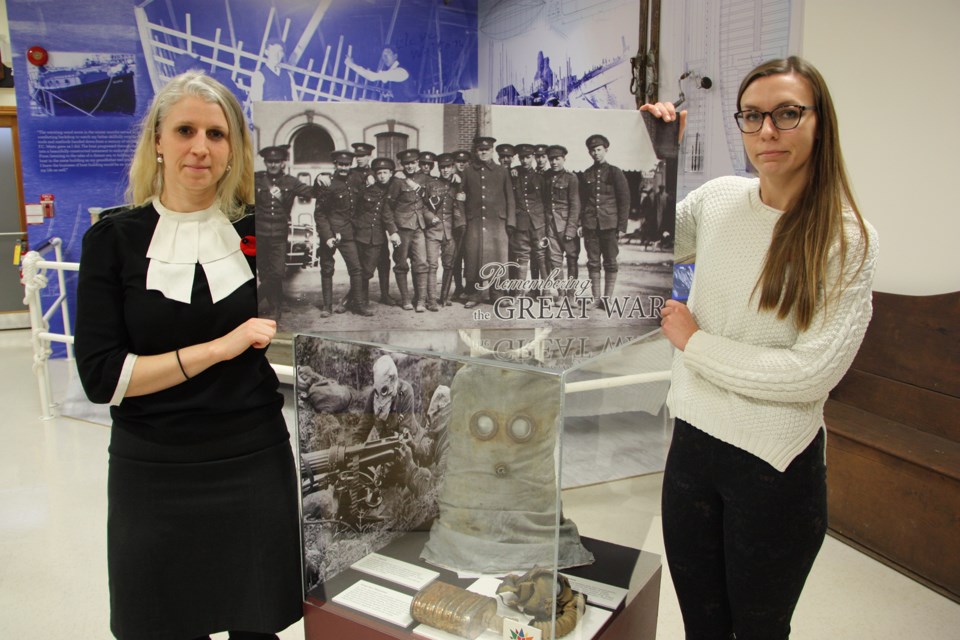You can see one of the first gas masks – called a PH Helmet – used by British and Canadian forces in the First World War at the Collingwood Museum this weekend.
This artifact – more than 100 years old – is part of the First World War exhibit at the museum, which will be on display until Monday at 5 p.m. The exhibit includes information panels, historic photographs from the front lines and the home front, the history of the Collingwood cenotaph, and, of course, the mask bearing an eerie resemblance to a scarecrow’s head. The special exhibit is on display to commemorate the 100th anniversary of Armistice Day – the end of the First World War.
Museum Assistant Melissa Shaw took CollingwoodToday for a tour of the exhibit.
The mask is treated fabric with round, glass eye pieces framed in rusted metal and a hose where the mouth would go. The soldier would have to inhale through his nose so the air passed through the treated fabric, then exhale through a tube in his mouth. The mask (also called a Tube Helmet) was designed to protect troops from chlorine, phosgene, and tear gasses. The helmet went through a few “improvements” adding hyzamethylene tetramine (a mix of formaldehyde and ammonia) to the chemicals used to treat the fabric. A rubber sponge facepiece was added in 1916 to protect against tear gas. Eventually, the cumbersome mask was replaced by a small box respirator (late 1916) which reportedly worked better against gas in higher concentrations. The Collingwood museum also has a small box respirator on display, thanks to the collecting work of the Huron Institute, the museum’s predecessor.
While the mask was likely issued to most troops that fought under the Union Jack, including 700 from the Simcoe Battalions, it was cumbersome enough that many soldiers opted to urinate on a rag and wrap that around their mouth and nose to counteract a chlorine gas attack.
The museum collection includes letters, postcards, and missing in action reports sent home from the front lines to friends and family in Collingwood.
Collingwood’s first group of soldiers went overseas as part of the A Company in the 157th Batallion. They went with other volunteers from Simcoe County.
In fact, the A Company helped start what was then called Camp Borden, and is today’s Canadian Forces Base Borden near Alliston, Ontario.
A copy of a recruitment leaflet that would have been distributed in Collingwood gives an idea of the tactics used to encourage volunteers. One question asks if you can give a reasonable explanation why you’re not in uniform.
Collingwood’s Shipyards also played a role in the First World War, building Trollers (minesweepers) in the Collingwood harbour. The shipyards also built deep sea cargo vessels like the War Witch. While the War Witch never saw action in the First World War, it did do battle in the Second World War and was sunk by the Allies. Collingwood museum staff can tell you how that happened and why it came under fire by the Allied ships.
The final component of the First World War exhibit at the Collingwood museum is the history of Collingwood’s cenotaph. The monument – a lone bugler cast in bronze – was designed by Charles Macdonald. The town held a competition to find a design for their new cenotaph and Macdonald was the winner.
He and his brother, Fred, both joined the 48th Highlanders of Canada and fought in the First World War. Charles was injured in the battle of Langemarck (Ypres) in April 1915 and spent three years as a prisoner of war under the Germans.
Charles crafted the bugler using his brother Fred as the inspiration. The original cenotaph was unveiled on the train station grounds on Aug. 5, 1923 and was refurbished and rededicated in 2007.
To see the antique fabric gas mask, photos of local soldiers, letters home, and victory bond advertisements, visit the Collingwood Museum Friday through Monday from 9 a.m. to 5 p.m.
The exhibit is being taken down after close on Monday evening and the Museum gallery will be closed Tuesday through Friday next week. Admission to the museum is by donation.
